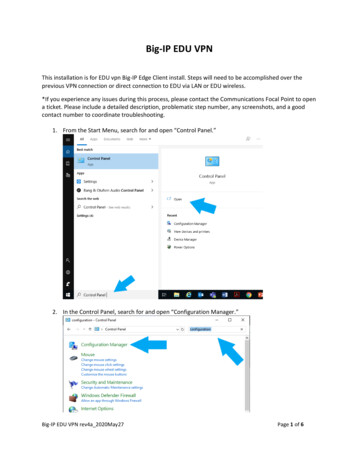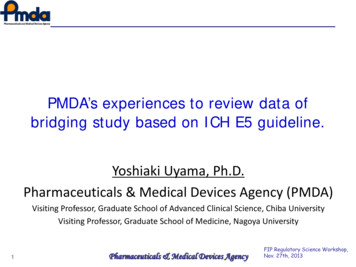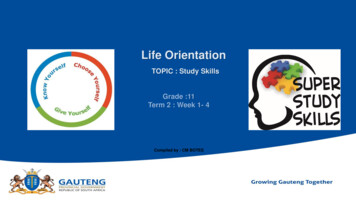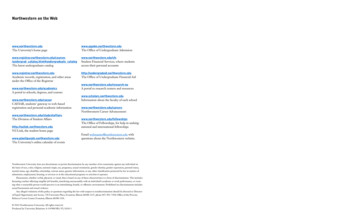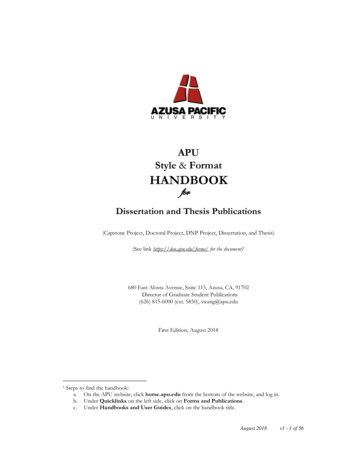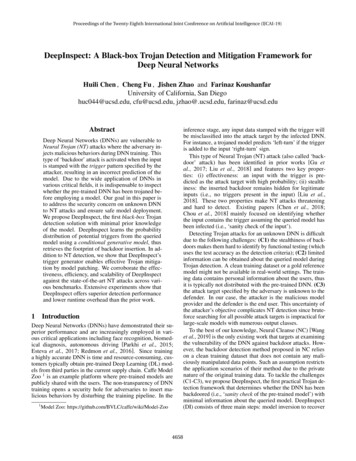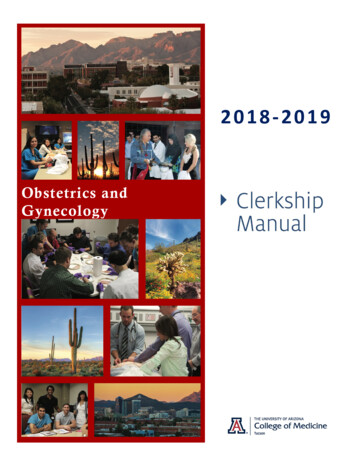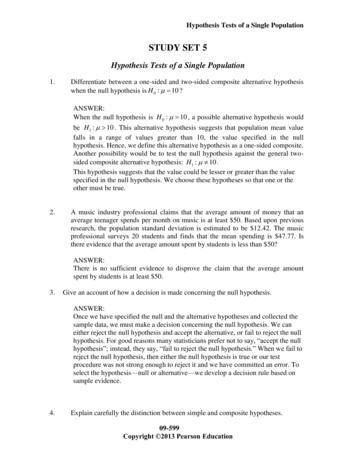
Transcription
Hypothesis Tests of a Single PopulationSTUDY SET 5Hypothesis Tests of a Single Population1.Differentiate between a one-sided and two-sided composite alternative hypothesiswhen the null hypothesis is H 0 : 10 ?ANSWER:When the null hypothesis is H 0 : 10 , a possible alternative hypothesis wouldbe H1 : 10 . This alternative hypothesis suggests that population mean valuefalls in a range of values greater than 10, the value specified in the nullhypothesis. Hence, we define this alternative hypothesis as a one-sided composite.Another possibility would be to test the null hypothesis against the general twosided composite alternative hypothesis: H1 : 10 .This hypothesis suggests that the value could be lesser or greater than the valuespecified in the null hypothesis. We choose these hypotheses so that one or theother must be true.2.A music industry professional claims that the average amount of money that anaverage teenager spends per month on music is at least 50. Based upon previousresearch, the population standard deviation is estimated to be 12.42. The musicprofessional surveys 20 students and finds that the mean spending is 47.77. Isthere evidence that the average amount spent by students is less than 50?ANSWER:There is no sufficient evidence to disprove the claim that the average amountspent by students is at least 50.3.Give an account of how a decision is made concerning the null hypothesis.ANSWER:Once we have specified the null and the alternative hypotheses and collected thesample data, we must make a decision concerning the null hypothesis. We caneither reject the null hypothesis and accept the alternative, or fail to reject the nullhypothesis. For good reasons many statisticians prefer not to say, “accept the nullhypothesis”; instead, they say, “fail to reject the null hypothesis.” When we fail toreject the null hypothesis, then either the null hypothesis is true or our testprocedure was not strong enough to reject it and we have committed an error. Toselect the hypothesis—null or alternative—we develop a decision rule based onsample evidence.4.Explain carefully the distinction between simple and composite hypotheses.09-599Copyright 2013 Pearson Education
ANSWER:A simple hypothesis assumes a specific value for the population parameter that isbeing tested. A composite hypothesis assumes a range of values for the populationparameter.5.Explain the relationship between Type I error and Type II error in a hypothesistest.ANSWER:Ideally, we would like to have the probabilities of both types of errors be as smallas possible. However, there is a trade-off between the probabilities of the twotypes of errors. Given a particular sample, any reduction in the probability ofType I error, α, will result in an increase in the probability of Type II error, β, andvice versa, although it is not a direct linear substitution.6.The supervisor of a production line believes that the average time to assemble anelectronic component is 14 minutes. Assume that assembly time is normallydistributed with a standard deviation of 3.4 minutes. The supervisor times theassembly of 14 components, and finds that the average time for completion was11.6 minutes. Is there evidence that the average amount of time required toassemble a component is something other than 14 minutes? Use 0.01.ANSWER:We conclude that there is sufficient evidence to disprove the claim that theaverage time to assemble an electronic component is 14 minutes (The populationmean appears to be less than 14 minutes.)7.Explain the distinction between Type I and Type II errors.ANSWER:A Type I error is falsely rejecting the null hypothesis. To commit a Type I error,the truth must be that the null hypothesis is really true and yet you conclude toreject the null and accept the alternative. A Type II error is falsely not rejectingthe null hypothesis when in fact the null hypothesis is false. To make a Type IIerror, the null hypothesis must be false (the alternative is true) and yet youconclude not to reject the null hypothesis.8.How is the power of a test connected to the decision rule in hypothesis testing?ANSWER:The decision rule is determined by the significance level chosen for the test,therefore the concept of power does not directly affect the decision to reject or failto reject a null hypothesis. However, by computing the power of the test forparticular significance levels and values of population parameters included in H 1 ,we will have valuable information about the properties of the decision rule. For09-600Copyright 2013 Pearson Education
Hypothesis Tests of a Single Populationexample, we will see that, by taking a larger sample size, the power of the testwill be increased for a given significance level, . Another important use ofpower calculations occurs when, for a given sample size, we have a choicebetween two or more possible tests with the same significance levels. Then itwould be appropriate to choose the test that has the smallest probability of Type IIerror—that is, the test with the highest power.9.Explain the distinction between the significance level and the power of the test.ANSWER:Significance level is the chosen level of significance that established theprobability of a making a Type I error. This is represented by . A Type II error,that arises when we fail to reject a false null hypothesis. For a particular decisionrule, the probability of making such an error when the null hypothesis is false willbe denoted as . Then the probability of rejecting a false null hypothesis is(1 ) , which is called the power of the test.10.The manufacturer of a new product claims that his product will increase outputper machine by at least 38 units per hour. A line manager adopts the product on18 of his machines, and finds that the average increase was only 35 units per hourwith a standard deviation of 12.2 units. Is there evidence to doubt themanufacturer’s claim at a significance level of .10?ANSWER:There is insufficient evidence to disprove the claim that the product will increaseoutput per machine by 38 units per hour.11. How does sample size affect the decision to reject or failure to reject of a nullhypothesis?ANSWER:The null hypothesis has the status of a maintained hypothesis—one held to betrue—unless the data contain strong evidence to reject the hypothesis. By settingthe significance level, at a low level, we have a small probability of rejecting atrue null hypothesis. When we reject a true null hypothesis, the probability oferror is the significance level, . But if there is only a small sample, then we willreject the null hypothesis only when it is wildly in error. As we increase thesample size, the probability of rejecting a false null hypothesis is increased. Butfailure to reject a null hypothesis leads to much greater uncertainty because we donot know the probability of the Type II error. Thus, if we fail to reject, then eitherthe null hypothesis is true or our procedure for detecting a false null hypothesisdoes not have sufficient power—for example, the sample size is too small.12.The manufacturer of a new chewing gum claims that at least eight out of tendentists surveyed prefer their type of gum and recommend it for their patientswho chew gum. An independent consumer research firm decides to test their09-601Copyright 2013 Pearson Education
claim. The findings in a sample of 400 doctors indicate that 76% do actuallyprefer their gum. Is this evidence sufficient to doubt the manufacturer’s claim?Use 0.05.ANSWER:There is sufficient evidence to doubt the manufacturer’s claim.13.A magazine advertises that at least 65% of all their readers are women. Awoman’s group wants to test this assertion and they take a sample of 300households, and find that only 61.3% of the readers are women. From the data, isthere sufficient evidence to doubt the magazine’s claim at a 10% level ofsignificance?ANSWER:Therefore, there is sufficient evidence to doubt the magazine’s claim at the 10%level of significance.14. How is hypothesis testing a counterfactual argument?ANSWER:When we reject the null hypothesis, we have strong evidence that the nullhypothesis is not true and, therefore, that the alternative hypothesis is true. If weseek strong evidence in favor of a particular outcome, we define that outcome asthe alternative hypothesis, H 1 , and the other outcome as the null hypothesis, H 0 .This is called a counterfactual argument. When we reject H 0 , there is strongevidence in favor of H 1 , and we are confident that our decision is correct. Butfailing to reject H 0 leads to greater uncertainty.15.The manufacturer of bags of cement claims that they fill each bag with at least50.2 pounds of cement. Assume that the standard deviation for the amount in eachbag is 1.2 pounds. The decision rule is adopted to shut down the filling machine ifthe sample mean weight for a sample of 40 bags is below 49.8. Suppose that thetrue mean weight of bags is 50 pounds. Using this decision rule, what is theprobability of a Type II error?ANSWER:0.146916.A professional rock climber claims that he can climb a particular mountain withinhalf an hour. From a random sample of 20 attempts, the rock climber averaged33.3 minutes with a standard deviation of 3.9 minutes. Is there sufficient evidenceto suggest that the climber’s claim is incorrect at a significance level of 10 percent?ANSWER:09-602Copyright 2013 Pearson Education
Hypothesis Tests of a Single PopulationThere is sufficient evidence to disprove the climber’s claim.17. Thomas is a shift manager at a local fast food place, and is responsible for qualitymanagement. Thomas wants to ensure that all the frozen hamburger patties thatget delivered by the supplier weigh four ounces on average. Assume that thestandard deviation of the weight of hamburger patties is known to be 0.1 ounces.Thomas tells one of his employees that as a shipment arrives, select 25 patties atrandom and find the average weight for the 25 patties. For what average weightwould you tell the employee to reject the shipment, if you wanted the probabilityof a Type I error to be 0.10 or less?ANSWER:Reject the shipment if the average weight of the 250 sampled patties is 3.9744ounces.18. Provide an example of two-sided alternative hypotheses.ANSWER:There are some problems where deviations either too high or too low are of equalimportance. Such problems are tested using a two-sided alternative hypothesis.For example, the diameter of an automobile engine piston cannot be too large ortoo small. In those situations we consider the test of the null hypothesisH 0 : 0against the alternative hypothesisH1 : 0Here, we have no strong reason for suspecting departures either above or belowthe hypothesized population mean, 0 . The null hypothesis would be doubted ifthe sample mean were much greater or much smaller than 0 .19.An assembly line will be shut down for maintenance if the defect rate exceeds4.6%. Suppose you adopt a 5% significance level and take a random sample of 375items off the assembly line and compute the proportions that are defective. Forwhat value of the sample proportion will the assembly line be shut down?ANSWER:Assembly line will be shut down for maintenance if ( p̂ -0.046) / 0.0108 1.645,or equivalently if the sample proportion exceeds 0.0637.20.A gaming control board claims that the average household income of those peopleplaying blackjack at casinos is at least 50,000. Assume that the distribution ofhousehold income of those people playing blackjack is normally distributed witha standard deviation of 7,559. Suppose that for a sample of 45 households, it isfound that the average income was 48,326. Is the gaming control board incorrect09-603Copyright 2013 Pearson Education
in asserting that the average household income of blackjack players is at least 50,000? Use the 10 per cent significance level.ANSWER:There is sufficient evidence to disprove the claim of the gaming control board.21.A fitness club claims that the average age of its members is 42. Assume that theages are normally distributed. You believe that the average age is less than 42,therefore, you ask the ages of a few of the fitness club’s members and get thefollowing values: 40, 55, 50, 33, 38, 35, 30, and 45. Do you have any reason atthe 10 per cent level of significance to think the fitness club’s claim is incorrect?ANSWER:Therefore, there is insufficient evidence to disprove the claim.22.List out the features of a power function in hypothesis testing.ANSWER:The power function has the following features:1. The farther the true mean is from the hypothesized mean 0 , the greater is thepower of the test—everything else being equal.2. The smaller the significance level( ) of the test, the smaller the power—everything else being equal. Thus, reducing the probability of Type I error increases the probability of Type II error , but reducing by 0.01 does notgenerally increase by 0.01; the changes are not linear.3. The larger the population variance, the lower the power of the test—everythingelse being equal.4. The larger the sample size, the greater the power of the test—everything elsebeing equal. Note that larger sample sizes reduce the variance of the sample meanand, thus, provide a greater chance that we will reject H 0 when it is not correct.5. The power of the test at the critical value is the probability that a sample mean is above ( xc ), is that value.23.A local transportation planning group is concerned about the lack of car-poolingon the part of commuters. They are afraid that the proportion of local drivers carpooling is below the national average of 15%. A survey of 400 local driversreveals that 12.22% of them car pool. Is there evidence that the actual proportionof local commuters car-pooling is less than 15%? Test at the 10% level ofsignificance.ANSWER:There is sufficient evidence that the actual proportion of local commuters carpooling is less than 15%.09-604Copyright 2013 Pearson Education
Hypothesis Tests of a Single Population24.Explain the hypothesis test of the population proportion for large sample sizes.ANSWER:We begin by assuming a random sample of n observations from a populationthat has a proportion P whose members possess a particular attribute. IfnP(1 – P) 5 and the sample proportion is p̂ , then the following tests havesignificance level .1. To test either the hypothesisH 0 : P P0 or H1 : P P0against the alternativeH1 : P P0the decision rule is as follows:pˆ P0 z reject H 0 ifP0 (1 P0 ) / n2. To test either null hypothesisH 0 : P P0 or H1 : P P0against the alternativeH1 : P P0the decision rule is as follows:pˆ P0 z reject H 0 ifP0 (1 P0 ) / n3. To test either null hypothesisH 0 : P P0against the alternativeH1 : P P0the decision rule is as follows:pˆ P0 z /2reject H 0 ifP0 (1 P0 ) / npˆ P0 z /2or reject H 0 ifP0 (1 P0 ) / n25.Suppose that you want to test H0 : 277 against H1 : 277 at 0.10, andyou know that the population standard deviation 13.5. If you randomly selecta sample of 20 observations, for what values of the sample mean will you rejectthe null hypothesis?ANSWER:Reject H 0 for sample mean x k 277 -1.645(3.019) 272.03 or sample meanx k 277 1.645(3.019) 281.97.09-605Copyright 2013 Pearson Education
26.Provide the test for mean of a normal distribution with population varianceunknown, with the null hypothesis H 0 : 0 .ANSWER:Since the null hypothesis isH 0 : 0the alternate hypothesis would beH 0 : 0the decision rule isreject H 0 if t x 0 tn 1, s/ nor equivalentreject H 0 if x xc 0 tn 1, s / nTHE NEXT TWO QUESTIONS ARE BASED ON THE FOLLOWING INFORMATION:The marketing department for a hand calculator claims the battery pack performs 20,000calculations before it has to be recharged. The quality control manager for themanufacturer is entrusted with validating the claim that the battery pack works as long asthe specifications state in order to secure a large order from a key customer. A test of 114battery packs yields an average of 19,695 calculations with a standard deviation of 1,103.27.Formulate the appropriate null and alternative hypotheses.ANSWER:H0 : 20,000, H1 : 20,000.09-606Copyright 2013 Pearson Education
Hypothesis Tests of a Single Population28.Calculate the appropriate test statistic and p-value.ANSWER:t -2.952Since df n -1 113, and t ,0.005 2.576 , then p-value 0.005.29.How is the p-value computed for a two-sided alternative given a null hypothesisH 0 : 0 for the mean of a normal distribution with known variance?ANSWER:The p-values can be computed by noting that the corresponding tail probabilitywould be doubled to reflect a p-value that refers to the sum of the upper- andlower-tail probabilities for the positive and negative values of z. the p-value forthe two-tailed test of H 0 : 0 is x 0 p-value 2 P z p /2 H 0 : 0 / n where z p /2 is the standard normal value associated with the smallestprobability of rejecting the null hypothesis at either tail of the probabilitydistribution.THE NEXT THREE QUESTIONS ARE BASED ON THE FOLLOWING INFORMATION:A team of builders has surveyed buyers of their new homes for years. Consistently, only41% of the buyers have indicated that they were “quite satisfied” or “very satisfied” withthe construction quality of their homes. The builders have implemented new proceduresand adopted a revised quality-inspection system to ultimately improve customersatisfaction. They have surveyed 104 buyers since implementing changes; these buyersseem representative, with no systematic changes from past purchasers. Of the 104 buyers,52 indicated they were quite or very satisfied.30.What kind of alternative hypothesis type would fit such a survey?ANSWER:H1 : P 0.4131.Calculate the appropriate statistic for testing the null hypothesis.ANSWER:1.8732.Test the null hypothesis with the alternative hypothesis, H1 : P 0.41, at 0.05.ANSWER:09-607Copyright 2013 Pearson Education
We conclude there is sufficient evidence that adopting the revised qualityinspection system has improved the proportion of customer satisfaction.33.How is the probability making a Type II error found in population proportiontests?ANSWER:The probability, , of making a Type II error for any given population proportionP1 included in H 1 is found as follows:1. From the test decision rule, find the range of values of the sample proportionleading to failure to reject the null hypothesis.2. Using the value P1 for the population proportion—where P1 is included in thealternative hypothesis—find the probability that the sample proportion will be inthe nonrejection region determined in step 1 for samples of n observations whenthe population proportion is P1 .THE NEXT THREE QUESTIONS ARE BASED ON THE FOLLOWING INFORMATION:A pharmaceutical manufacturer is concerned that the mean impurity concentration in pillsshould not exceed 3%. It is known that from a particular production run impurityconcentrations follow a normal distribution with a standard deviation 0.4%. A randomsample of 36 pills from a production run was checked, and the sample mean impurityconcentration was found to be 3.09%.34.Test at the 5% level, the null hypothesis that the population mean impurityconcentration is 2% or less against the alternative that it is more than 3%.ANSWER:We conclude that the population mean impurity concentration is 3% or less.35.Calculate the p-value for this test.ANSWER:p -value P( Z 1.35 0.088536.In the context of this problem, explain why a one-sided alternative hypothesis ismore appropriate than a two-sided alternative.ANSWER:A one-sided alternative is more appropriate since we are not interested indetecting possible low levels of impurity, only high levels of impurity.37.How is hypothesis testing used in problems that have high variance levels?ANSWER:Here, we will develop procedures for testing the population variance, 2 , based09-608Copyright 2013 Pearson Education
Hypothesis Tests of a Single Populationon the sample variance, s 2 , computed using a random sample of n observationsfrom a normally distributed population. If the null hypothesis is that thepopulation variance is equal to some specified value, that is,H 0 : 2 20then when this hypothesis is true, the random variable(n 1) s 2X n2 1 02has a chi-square distribution with (n - 1) degrees of freedom. Hypothesis tests arebased on computed values of this statistic. If the alternative hypothesis wereH1 : 2 02we would reject the null hypothesis if the sample variance greatly exceeded 02 .Thus, a high computed value of X n2 1 would result in the rejection of the nullhypothesis. Conversely, if the alternative hypothesis wereH1 : 2 02we would reject the null hypothesis if the value of X n2 1 were small. For a twosided alternativeH1 : 2 02we would reject the null hypothesis if the computed X n2 1 were either unusuallyhigh or unusually low.THE NEXT THREE QUESTIONS ARE BASED ON THE FOLLOWING INFORMATION:An engineering research center claims that, through the use of a new computer controlsystem, automobiles should achieve, on average, at least an additional 5 miles per gallonof gas. A random sample of 81 automobiles was used to evaluate this product. Thesample mean increase in miles per gallon achieved was 4.5, and the sample standarddeviation was 2.9 miles per gallon.38.State the appropriate null and alternative hypotheses.ANSWER:H0 : 5 and H1 : 5 .39.Test the hypothesis at the 5% level.ANSWER:We conclude that through the use of a new computer control system, automobilesshould achieve, on average, at least an additional 5 miles per gallon of gas.40.Find the p-value of this test, and interpret the results.ANSWER:09-609Copyright 2013 Pearson Education
p-value P(t -1.55) 0.0623. This means that H 0 would be rejected for anysignificance level above 6.23%.41.When is the chi-square distribution test not reliable for testing in hypothesis tests?ANSWER:The chi-square distribution tests are more sensitive to the assumption of normalityin the underlying distribution compared to the standard normal distribution tests.Thus, if the underlying population deviates considerably from the normal, thesignificance levels computed using the chi-square distribution and the hypothesistests may not be correct.THE NEXT THREE QUESTIONS ARE BASED ON THE FOLLOWING INFORMATION:A company selling new econometrics computer software advertises that firms using thissoftware obtain, on average during the first year, a yield of at least 10% on their initialinvestments. A random sample of 10 of the franchises that used the software producedthe following yields for the first year of operation: 9.4, 11.1, 10.4, 10.5, 11.2, 8.2, 8.5,4.0, 8.8, and 6.1. Assume that population yields are normally distributed.42.State the appropriate null and alternative hypotheses.ANSWER:H0 : 10 and H1 : 10 .43.Calculate the sample mean and sample standard deviation.ANSWER:x 8.82 and s 2.30144.Test the company’s claim at the 5% significance level.ANSWER:We conclude that firms using this new software obtain, on average during the firstyear, a yield of at least 10% on their initial investments.45.How does variance affect hypothesis testing in most applied situations?ANSWER:In most applied situations, and especially in quality-control work, the concern isabout variances that are larger than anticipated. A variance that is smaller thananticipated results in hypothesis tests with greater power and confidence intervalsthat are narrower than anticipated. The opposite is true when the variance is largerthan anticipated. Therefore, in most applied situations we are interested in thealternative hypothesisH1 : 2 0209-610Copyright 2013 Pearson Education
Hypothesis Tests of a Single Populationwhere the variance is larger than expected.46.On the basis of a random sample the null hypothesis: H0 : 0 is tested againstthe alternative: H1 : 0 and the null hypothesis is not rejected at the 10%significance level. Does this necessarily imply that 0 is contained in the 90%confidence interval for ?ANSWER:No, the 90% confidence level provides for 5% of the area in either tail. This doesnot correspond to a one-tailed hypothesis test with 10% which has 10% of thearea in one of the tails.THE NEXT TWO QUESTIONS ARE BASED ON THE FOLLOWING INFORMATION:In a random sample of 200 high school students, 92 sample members indicated somemeasure of agreement with this statement: “A prospective university’s academic rankingand image is important to my decision to attend that institution”.47.Test at the 5% level of significance the null hypothesis that one-half of all highschool students would agree with this statement against a two-sided alternative.ANSWER:We conclude that the proportion of high school students who would agree withthe above statement is not different from 0.50.48.Find and interpret the p-value of the test.ANSWER:The probability of finding a random sample with a sample proportion p̂ this far orfarther from 0.5 if the null hypothesis is really true is 0.2584.49.The Discovery Automobile Company is attempting to determine if it should retaina previously popular sports car model called El Nino. A random sample of 500consumers is obtained, and each person in the sample is asked if he/she would stillconsider purchasing an El Nino. To determine if El Nino should be retained, thesample proportion of respondents who said yes, p̂ , is used at a level 0.05 totest the hypothesis H0 : P 0.5 against H1 : P 0.5 . What value of the sampleproportion, p̂ , is required to reject the null hypothesis?ANSWER:pˆ 0.4636 or 46.36%.50.A random sample of 250 business faculty members was asked if there should be arequired foreign language course for international business majors. Of thesesample members, 170 felt there was a need for a foreign language course. Test the09-611Copyright 2013 Pearson Education
hypothesis that at least 75% of all business faculty members hold this view. Use 0.05.ANSWER:We conclude that less than 75% of all business faculty members hold the viewthat there should be a required foreign language course for international businessmajors.THE NEXT FOUR QUESTIONS ARE BASED ON THE FOLLOWING INFORMATION:Consider a problem with the hypothesis test H0 : 4 against H1 : 4 , and thefollowing decision rule: Reject H 0 if51.x 4 1.645 .0.08 / 25Rewrite the decision rule explicitly in terms of x .ANSWER:x 4 1.645 x 4 1.645 0.08/ 25 4.026 Reject H 0 if x 4.0260.08 / 25 52. Compute the probability of Type II error and the power of the test for 4.06.ANSWER:Power 1 - 1 – 0.0166 0.983453.Compute the probability of Type II error and the power of the test for 4.04.ANSWER:Power 1 - 1 – 0.1894 0.810654.Compute the probability of Type II error and the power of the test for 4.0.ANSWER:Power 1 - 1 – .9484 0.0516.THE NEXT TWO QUESTIONS ARE BASED ON THE FOLLOWING INFORMATION:Manufacturing planning wants to estimate plant capacity in order to schedule customerorders and improve on-time delivery. A random sample of ten days output gave thefollowing results for numbers of finished components produced: 577, 642, 615, 655, 600,570, 640, 620, 595, and 575. Planning is concerned about the variability of daily outputand views as undesirable any variance above 525.55.Calculate the sample variance.09-612Copyright 2013 Pearson Education
Hypothesis Tests of a Single PopulationANSWER:s2 922.32256.Test at the 10% significance level the null hypothesis that the population variancefor daily output does not exceed 525.ANSWER:We conclude that the population variance for daily output exceeds 525.57. A large milling machine produces steel rods. The machine is considered to beoperating within customer specifications if the standard deviation of the diameterof the rods is 0.15 inches. As line supervisor, you need to demonstrate whether themachine is capable of meeting customer specifications. Based on a sample of 25rods, the sample standard deviation is 0.19. Is there sufficient evidence at the 5%significance level to conclude that the machine is not operating within thecustomer tolerances?ANSWER:There is sufficient evidence at the 5% significance level to conclude that themachine is not operating normally.58.The concentration of a drying compound is critical in gauging the final strength ofan adhesive product. The standard deviation of the amount of the compound mustbe 1,500 parts-per-million (ppm) or less. Based on a sample of 25 mixtures, thestandard deviation is 1,700 ppm. Is there reason to believe, at the 10 per centsignificance level, that the standard deviation of the drying compound is more than1,500 ppm? (Note: 1,500 ppm equals a proportion of .0015 and a percent of.000015.)ANSWER:We fail to reject null hypothesis at 0.10.There is no reason to believe at 0.10 that the standard deviation of the dryingcompound is more than 1,500 parts-per-million.THE NEXT THREE QUESTIONS ARE BASED ON THE FOLLOWING INFORMATION:A beer producer claims that the proportion of its customers who cannot distinguishregular from light beer is at most 12 percent. The producer decides to test this nullhypothesis against the alternative that the true proportion is more than 12 percent. Thedecision rule adopted is to reject the null hypothesis if the sample proportion of whocannot distinguish between the two beers exceeds 15 percent.59.If a random sample of 100 customers is chosen, what is the probability of a Type Ierror, using this decision rule?ANSWER:09-613Copyright 2013 Pearson Education
H0 : P 0.12 and H1 : P 0.12 .The decision rule is: Reject H 0 if p̂ 0.150.178860.If a random sample of 400 customers is selected, what is the probability of a TypeI error,
2. A music industry professional claims that the average amount of money that an average teenager spends per month on music is at least 50. Based upon previous research, the population standard deviation is estimated to be 12.42. The music professional surveys 20 students and finds that the mean spending is 47.77. Is
